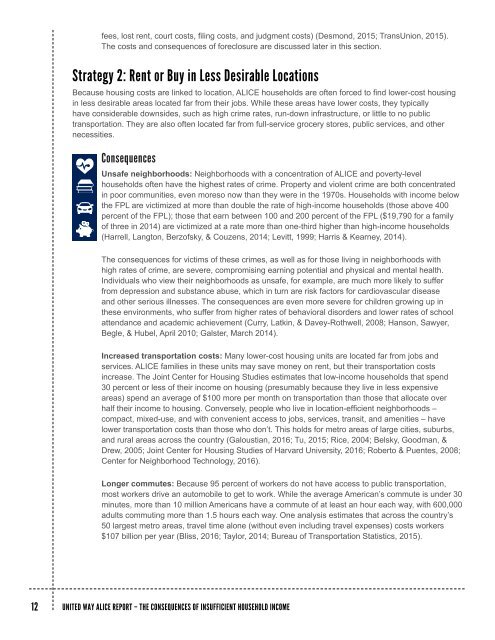The Consequences of Insufficient Household Income
This new Consequences of Insufficient Household Income report provides a deeper level of understanding of the choices that ALICE and poverty-level families across the country make when they do not have enough income or assistance to afford basic necessities, and the consequences of those choices.
This new Consequences of Insufficient Household Income report provides a deeper level of understanding of the choices that ALICE and poverty-level families across the country make when they do not have enough income or assistance to afford basic necessities, and the consequences of those choices.
You also want an ePaper? Increase the reach of your titles
YUMPU automatically turns print PDFs into web optimized ePapers that Google loves.
fees, lost rent, court costs, filing costs, and judgment costs) (Desmond, 2015; TransUnion, 2015).<br />
<strong>The</strong> costs and consequences <strong>of</strong> foreclosure are discussed later in this section.<br />
Strategy 2: Rent or Buy in Less Desirable Locations<br />
Because housing costs are linked to location, ALICE households are <strong>of</strong>ten forced to find lower-cost housing<br />
in less desirable areas located far from their jobs. While these areas have lower costs, they typically<br />
have considerable downsides, such as high crime rates, run-down infrastructure, or little to no public<br />
transportation. <strong>The</strong>y are also <strong>of</strong>ten located far from full-service grocery stores, public services, and other<br />
necessities.<br />
<strong>Consequences</strong><br />
Unsafe neighborhoods: Neighborhoods with a concentration <strong>of</strong> ALICE and poverty-level<br />
households <strong>of</strong>ten have the highest rates <strong>of</strong> crime. Property and violent crime are both concentrated<br />
in poor communities, even moreso now than they were in the 1970s. <strong>Household</strong>s with income below<br />
the FPL are victimized at more than double the rate <strong>of</strong> high-income households (those above 400<br />
percent <strong>of</strong> the FPL); those that earn between 100 and 200 percent <strong>of</strong> the FPL ($19,790 for a family<br />
<strong>of</strong> three in 2014) are victimized at a rate more than one-third higher than high-income households<br />
(Harrell, Langton, Berz<strong>of</strong>sky, & Couzens, 2014; Levitt, 1999; Harris & Kearney, 2014).<br />
<strong>The</strong> consequences for victims <strong>of</strong> these crimes, as well as for those living in neighborhoods with<br />
high rates <strong>of</strong> crime, are severe, compromising earning potential and physical and mental health.<br />
Individuals who view their neighborhoods as unsafe, for example, are much more likely to suffer<br />
from depression and substance abuse, which in turn are risk factors for cardiovascular disease<br />
and other serious illnesses. <strong>The</strong> consequences are even more severe for children growing up in<br />
these environments, who suffer from higher rates <strong>of</strong> behavioral disorders and lower rates <strong>of</strong> school<br />
attendance and academic achievement (Curry, Latkin, & Davey-Rothwell, 2008; Hanson, Sawyer,<br />
Begle, & Hubel, April 2010; Galster, March 2014).<br />
Increased transportation costs: Many lower-cost housing units are located far from jobs and<br />
services. ALICE families in these units may save money on rent, but their transportation costs<br />
increase. <strong>The</strong> Joint Center for Housing Studies estimates that low-income households that spend<br />
30 percent or less <strong>of</strong> their income on housing (presumably because they live in less expensive<br />
areas) spend an average <strong>of</strong> $100 more per month on transportation than those that allocate over<br />
half their income to housing. Conversely, people who live in location-efficient neighborhoods –<br />
compact, mixed-use, and with convenient access to jobs, services, transit, and amenities – have<br />
lower transportation costs than those who don’t. This holds for metro areas <strong>of</strong> large cities, suburbs,<br />
and rural areas across the country (Galoustian, 2016; Tu, 2015; Rice, 2004; Belsky, Goodman, &<br />
Drew, 2005; Joint Center for Housing Studies <strong>of</strong> Harvard University, 2016; Roberto & Puentes, 2008;<br />
Center for Neighborhood Technology, 2016).<br />
Longer commutes: Because 95 percent <strong>of</strong> workers do not have access to public transportation,<br />
most workers drive an automobile to get to work. While the average American’s commute is under 30<br />
minutes, more than 10 million Americans have a commute <strong>of</strong> at least an hour each way, with 600,000<br />
adults commuting more than 1.5 hours each way. One analysis estimates that across the country’s<br />
50 largest metro areas, travel time alone (without even including travel expenses) costs workers<br />
$107 billion per year (Bliss, 2016; Taylor, 2014; Bureau <strong>of</strong> Transportation Statistics, 2015).<br />
12 UNITED WAY ALICE REPORT – THE CONSEQUENCES OF INSUFFICIENT HOUSEHOLD INCOME




